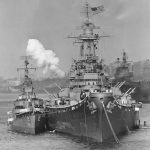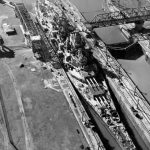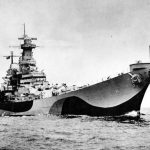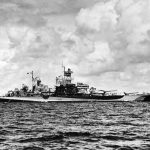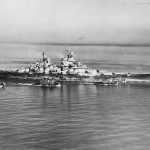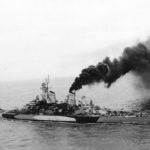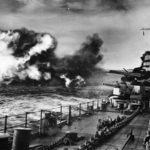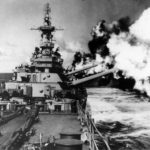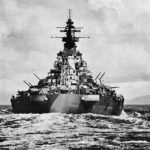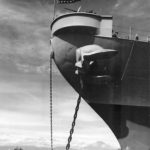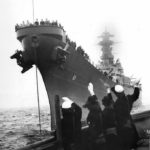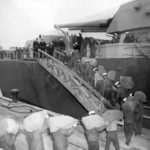USS Missouri Passes under Brooklyn Bridge
USS Renshaw Missouri Lexington at New York City
USS Missouri passing the Panama Canal October 1945
USS Missouri Passes under Brooklyn Bridge
USS Missouri Panama Canal 1945
USS Missouri in Ms 32/22D paint scheme
USS Missouri during the surrender ceremony in 1945
USS Missouri in camouflage
USS Missouri
USS Missouri
Tugs around USS Missouri 1945
New Yorkers Visit USS Missouri
USS Missouri and carrier Coral Sea
USS Missouri Leaving Bayonne 1947
USS Missouri underway in 1945
Planes over battleship USS Missouri during Japanese surrender 2 September 1945
Battleship USS Missouri (BB-63) firing her 16 Inch guns
USS Missouri (BB-63) firing her 16 Inch guns 1945
Battleship USS Missouri in 1945
USS Missouri (BB-63) ploughing thru rough seas en route to Japan ’45
Stern View of USS Missouri ’44
USS Missouri (BB-63) at anchor in Tokyo Bay 1945
Projectiles in air as battleship USS Missouri fires 406 mm (16 in) guns
Battleship USS Missouri (BB-63) in Measure 32/22d camouflage paint scheme
Girls wave as returning USS Missouri docks at Pier 90 in New York 1945
USS Missouri (BB-63) mail delivery 1945
Japanese Zero Kamikaze About to Hit USS Missouri BB-63 off Okinawa 11 April 1945
Launch of Battleship USS Missouri BB-63 29 January 1944
USS Missouri BB-63 in camouflage
Japanese surrender delegation aboard the USS Missouri BB-63 1945
Missouri (BB-63), the last battleship completed by the United States, was laid down 6 January 1941 by New York Naval Shipyard. Launched 29 January 1944 sponsored by Miss Margaret Truman, daughter of then Senator from Missouri Harry S Truman, later president and commissioned 11 June 1944. C’apt. William M. Callaghan in command.
After trials off New York and shakedown and battle practice In Chesapeake Bay, Missouri departed Norfolk 11 November 1944, transited the Panama Canal 18 November and steamed to San Francisco for final fitting out as fleet flagship. She stood out of San Francisco Bay 14 December and arrived Ulithi, West Caroline Islands, 13 January 1945. There she was temporary headquarters ship for Vice Adm. Marc A. Mitscher. The battleship put to sea 27 January to serve in the screen of the Lexington carrier task group of Mitscher’s TF 58, and on 16 February her flattops launched the first airstrikes against Japan since the famed Doolittle raid thad had been launched from carrier USS Hornet in April 1942. Missouri then steamed with the carriers to Iwo .lima where her guns provided direct and continuous support to the invasion landings begun 19 February. After TF 58 returned to Ulithi 5 March. Missouri was assigned to the USS Yorktown task group. On 14 March Missouri departed Ulithi in the screen of the fast carriers and steamed to the Japanese mainland. During strikes against targets along the coast of the Inland Sea of Japan beginning 18 March, Missouri shot down four Japanese aircraft. Raids against airfields and naval bases near the Inland Sea and southwestern Honshu continued USS Wasp, crashed by a kamikaze suicide plane 19 March, resumed flight operations within an hour. Two bombs penetrated the hangar deck and decks aft of carrier USS Franklin leaving her dead in the water within 59 miles of the Japanese mainland. Cruiser USS Pittsburgh took Franklin in tow until she gained speed to 14 knots. Missouri’s carrier task group provided cover for Franklin’s retirement toward Ulithi until 22 March, then set course for preinvasion strikes and bombardment of Okinawa.
Missouri joined the fast battleships of TF 58 in bombarding the southeast coast of Okinawa 24 March, an action intended to draw enemy strength from the west coast beaches that would be the actual site of invasion landings. Missouri rejoined the screen of the carriers as Marine and Army units stormed the shores of Okinawa on the morning of 1 April. Planes from the carriers shattered a special Japanese attacking force led by battleship Yamato 7 April. Yamato, the world’s largest battleship, was sunk, as were a cruiser and a destroyer. Three other enemy destroyers were heavily damaged and scuttled. Four remaining destroyers, sole survivors of the attacking fleet were damaged and retired to Sasebo.
On 11 April Missouri opened fire on a low-flying suicide plane which penetrated the curtain of her shells to crash just below her main deck level. The starboard wing of the plane was thrown far forward, starting a gasoline fire at 5-inch Gunmount No. 3. Yet the battleship suffered only superficial damage, and the fire was brought quickly under control. About 23.05 on 17 April. Missouri detected an enemy submarine 12 miles from her formation. Her report set off a hunter-killer operation by carrier Bataan and four destroyers which sank Japanese submarine I-56. Missouri was detached from the carrier task force off Okinawa 5 May and sailed for Ulithi. During the Okinawa campaign she had shot down five enemy planes, assisted in the destruction of six others, and scored one probable kill. She helped repel 12 daylight attacks of enemy raiders and fought off four night attacks on her carrier task group.
Her shore bombardment destroyed several gun emplacements and many other military, governmental, and industrial structures.
Missouri arrived Ulithi 9 May and thence proceeded to Apra Harbor, Guam, 18 May. That afternoon Adm. William F. Halsey, Jr., Commander 3d Fleet, broke his flag in Missouri. She passed out of the harbor 21 May, and by 27 May was again conducting shore bombardment against Japanese positions on Okinawa. Missouri now led the 3d Fleet in strikes on airfields and installations on Kyushu 2 and 3 June. She rode out a fierce storm 5 and 6 June that wrenched off the bow of cruiser USS Pittsburgh. Some topside fittings were smashed, but Missouri suffered no major damage. Her fleet again struck Kyushu 8 June, then hit hard in a coordinated air-surface bombardment before retiring towards Leyte. She arrived San Pedro, Leyte, 13 June, after almost 3 months of continuous operations in support of the Okinawa campaign. Here she prepared to lead the 3d Fleet in strikes at the heart of Japan from within its home waters. The mighty fleet set a northerly course 8 July to approach the Japanese mainland. Raids took Tokyo by surprise 10 July, followed by more devastation at the juncture of Honshu and Hokkaido 13 and 14 July. For the first time, a naval gunfire force wrought destruction on a major installation within the home islands when Missouri closed the shore to join in a bombardment 15 July that rained destruction on the Nihon Steel Co. and the Wanishi Ironworks at Muroran, Hokkaido. During the night of 17-18 July Missouri bombarded industrial targets in the Hichiti area. Honshu. Inland Sea aerial strikes continued through 25 July, and Missouri guarded the carriers as they struck hard blows at the Japanese capital. As July ended the Japanese no longer had any home waters. Missouri had led her fleet to gain control of the air and sea approaches to the very shores of Japan. Strikes on Hokkaido and northern Honshu resumed 9 August, the clay the second atomic bomb was dropped.
Next day, at 20.54, Missouri’s men were electrified by the unofficial news that Japan was ready to surrender, provided that the Emperor’s prerogatives as a sovereign ruler were not compromised. Not until 7.45, 15 August, was word received that President Truman had announced Japan’s acceptance of unconditional surrender. Adm. Sir Bruce Fraser (Commander, British Pacific Fleet) boarded Missouri 16 August, and conferred the order Knight of the British Empire upon Admiral Halsey. Missouri transferred a landing party of 200 officers and men to battleship Iowa for temporary duty with the initial occupation force for Tokvo 21 August. Missouri herself entered Tokyo Bay early 29 August to prepare for the normal surrender ceremony. High-ranking military officials of all the Allied Powers were received on board 2 September. Fleet Adm. Chester Nimitz boarded shortly after 8.00, and General of the Army Douglas MacArthur (Supreme Commander for the Allies) came on board at 8.43. The Japanese representatives, headed by Foreign Minister Mamoru Shigemitsu, arrived at 8.56. At 9002 General MacArthur stepped before a battery of microphones and the 23-minute surrender ceremony was broadcast to the waiting world.
By 9.30 the Japanese emissaries had departed. The afternoon of 5 September Admiral Halsey transferred his flag to battleship USS South Dakota. Early next day Missouri departed Tokyo Bay to receive homeward bound passengers at Guam, thence sailed unescorted for Hawaii. She arrived Pearl Harbor 20 September and flew Admiral Nimitz’ flag on the afternoon of 28 September for a reception.
The next day Missouri departed Pearl Harbor bound for the eastern seaboard of the United States. She reached New York City 23 October and broke the flag of Adm. Jonas Ingram, commander in chief. Atlantic Fleet. Battleship boomed out a 21-gun salute 27 October as President Truman boarded for Navy day ceremonies. In his address the President stated that “control of our sea approaches and of the skies above them is still the key to our freedom and to our ability to help enforce the peace of the world.”
Missouri received 3 battle stars for World War II service and 5 for Korean service.
Iowa-class battleship USS Missouri BB-63 (nick: “Mighty Mo” or “Big Mo”).
Laid down: 6 January 1941
Launched: 29 January 1944
Commissioned: 11 June 1944
Struck: 12 January 1995
Fate: Museum ship in Pearl Harbor
Main armament: 9 x 406 mm (16 in)
Bibliography:
- Navy Department, Office of the Chief of Naval Operations, Naval History Division: Dictionary of American Naval Fighting Ships, Volume IV
- Witold Koszela: The Battleship USS Missouri, Kagero Top Drawings 20
- Paul Stillwell: Battleship Missouri. An Illustrated History
- Kit Bonner, Carolyn Bonner: USS Missouri at War
- Turner Publishing: USS Missouri (BB-63)
- US NAVY FACT FILE Battleships BB-63 USS Missouri
- Stefan Draminski: The Battleship USS Missouri, Kagero Super Drawings in 3D
- Lawrence Burr, Paul Wright: US Fast Battleships 1938-91 – The Iowa Class, Osprey
- Mark Stille, Jim Laurier: US Navy Ships vs Kamikazes 1944-45, Osprey Duel
- Robert F. Sumrall, Thomas Walkowiak:Iowa Class Battleships: Their Design, Weapons and Equipment
- Robert F. Sumrall: USS Missouri (BB 63)
- Malcolm Muir: The Iowa Class Battleships: Iowa, New Jersey, Missouri & Wisconsin, Weapons and Warfare
- David Doyle: Iowa-Class Battleships, On Deck 26007
- Lester Abbey: Iowa Class Battleships
- ARTHUR C. UNGER: AMERICAN BATTLESHIPS: A Complete Chronology
- Max R. Newhart: American Battleships: A Pictorial History of BB-1 to BB-71
- Samuel Loring Morison, Norman Polmar: The American Battleship
- William H. Garzke Jr., Robert O. Dulin Jr: Battleships: United States Battleships, 1935-1992

